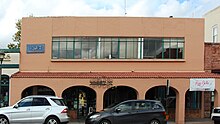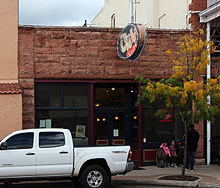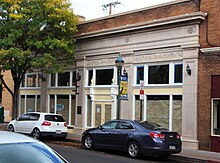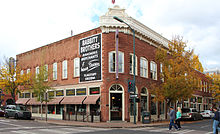Loading AI tools
Historic area From Wikipedia, the free encyclopedia
The Flagstaff Railroad Addition Historic District is significant because of its association with the Atchison, Topeka and Santa Fe Railway as well as U.S. Route 66. The original boundary was roughly bounded by Santa Fe RR tracks, Agassiz and Beaver Sts., Birch and Aspen Avenues. The district was expanded twice to add nine buildings along Phoenix Avenue from Beaver Street to San Francisco Avenue, and a building at 122 East Route 66.[2]
Railroad Addition Historic District | |
 Hotel Monte Vista | |
| Location | Roughly bounded by Santa Fe RR tracks, Agassiz and Beaver Sts., Birch and Aspen Aves., Flagstaff, Arizona |
|---|---|
| Area | 17.8 acres (7.2 ha) |
| Built | 1883 |
| Architect | Underwood, Gilbert Stanley; Et al. |
| Architectural style | Early Commercial, Romanesque, Classical Revival |
| MPS | Flagstaff MRA (AD) |
| NRHP reference No. | 83002989[1] (original) 86001360[1] (increase 1) 97001086[1] (increase 2) |
| Significant dates | |
| Added to NRHP | January 18, 1983 |
| Boundary increases | June 17, 1986 September 5, 1997 |
Disastrous fires swept through early Flagstaff; in 1897, the city passed an ordinance requiring all buildings in the business area to be built of brick, stone or iron. [3]
Several of the buildings in the District are associated with well-known businessmen of the late 1800s and early 1900s. These include John W. Weatherford, who constructed the Weatherford Hotel, the Babbitt brothers David, George, William and Charles, whose names are associated with several buildings in the District, and Thomas E. Pollock, Sr.[4]
| Name | Year Built | Architectural Style | Comments |
Flagstaff 1926 Depot
 |
1926 | Revival Tudor | Built during the boom years of the 1920s, and is now considered a symbol of Flagstaff. Today it is known as the Amtrak station and Visitor Center.[5] |
McMillan Building
 |
1886 | Hotel built out of native stone and locally made brick; bank located at corner[5] | |
Raymond Building
 |
1911 | Dr. Raymond was one of Flagstaff's earliest physicians; Moencopi sandstone around door[5] | |
Loy Building
 |
1897 | Loy was an attorney[5] | |
Citizen's Bank Building
 |
1903 | Constructed of Moencopi sandstone[5] | |
Flagstaff Telephone Exchange
 |
1909 | Was the first major telephone office; built by John Weatherford; reverted to restaurant in 1930; constructed of Moencopi sandstone[5] | |
Weatherford Hotel
 |
First section made 1898 and second section made in 1899 | Considered to be a downtown anchor since 1900; constructed of Moencopi sandstone[5] | |
Coalter Building
 |
1898 | Flagstaff's first Post Office[5] | |
Pollock Building
 |
1900–03 | Flagstaff's first library on the second floor[5] | |
Babbitt Building #1
 |
1907 | Flagstaff's second Post Office located here; constructed of tufa[5] | |
Babbitt Building #2
 |
1911[5] | ||
Elks Hall
 |
1899 | The Elks occupied the top floor; the first bowling alley in Flagstaff was in the basement; ground floor was a drug store[5] | |
Coconino Sun Building
 |
1926 | The Sun Newspaper has been Flagstaff's newspaper since 1891; it was moved to this location to make room for the Monte Vista Hotel[5] | |
Bikker Building #1
 |
1917 | Originally a harness shop; unusual shell of pebble siding added later[5] | |
Bikker Building #2
 |
1917 | First floor to house JCPenney, the first chain to come to Flagstaff; second floor Odd Fellows hall[5] | |
Monte Vista Hotel
 |
1926 | The construction on this hotel was a community effort, in 1926 raising $200,000 within 60 days[5] | |
Riordan Building
 |
1917 | Neoclassical | Flagstaff's 3rd Post Office[5] |
Babbitt Brothers Building
 |
1888 | Was originally a department store; it has been expanded many times, and restored to original appearance in 1990[5] | |
Babbitt's Garage
 |
1915 | The Babbitt brothers constructed this for automobiles, using reinforced concrete: a first for the area[5] | |
Masonic Temple
 |
1917 | Upper story housed the temple; ground floors and basement were rentals[5] | |
Federal Building
 |
1936 | Federal Modern style | Flagstaff's fifth Post Office[5] |
Hawks Building
 |
1897[5] | ||
Nackard Building
 |
1922 | Location of fourth Post office[5] | |
Brannen Building #3
 |
1887 | Housed town's first physician, D. J. Brannen, who had office and drug store here[5] | |
Brannen Building #5
 |
1883 | P.J. Brannen was first store owner to set up business in Flagstaff; the building burned once but was rebuilt using original stones[5] | |
Vail Building
 |
1888 | Art Deco | Most of Flagstaff's first businesses were saloons, catering to railroad workers; brawls and shootings were common; building made of brick, but stuccoed in 1939[5] |
Donahue Building
 |
1888 | Originally a saloon, and was owned by one of Flagstaff's most colorful characters, Sandy Donahue; built of brick and stuccoed in the 1930s[5] | |
Santa Fe Depot 1889
 |
1889 | Flagstaff's first train depot; in 1886, wooden depot destroyed by fire; present building made of Moencopi sandstone[5] |
Seamless Wikipedia browsing. On steroids.
Every time you click a link to Wikipedia, Wiktionary or Wikiquote in your browser's search results, it will show the modern Wikiwand interface.
Wikiwand extension is a five stars, simple, with minimum permission required to keep your browsing private, safe and transparent.